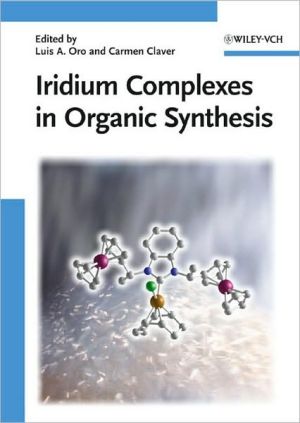

 |

|

Sold Out
Book Categories |
Preface.
List of Contributors.
1. Application of Iridium Catalysts in the Fine Chemicals Industry (Hans-Ulrich Bloser).
1.1 Introduction.
1.2 Industrial Requirements for Applying Catalysts.
1.3 Enantioselective Hydrogenation of C=N Bonds.
1.4 Enantioselective Hydrogenation of C=C Bonds.
1.5 Miscellaneous Catalytic Applications with Industrial Potential.
1.6 Conclusions and Outlook.
References.
2. Dihydrido Iridium Triisopropylphosphine Complexes: From Organometallic Chemistry to Catalysis (Luis A. Oro).
2.1 Introduction.
2.2 [Ir(COD) (NCMe) (PR₃)]BF₄ (PR₃ = Pi Pr3, PMe3)] and Related Complexes as Catalyst Precursors: Is 1,5-Cyclo-octadiene an Innocent and Removable Ligand?
2.3 The Dihydrido Iridium Triisopropylphosphine Complex [IrH₂(NCMe)₃(Pi Pr₃)]BF₄ as Alkyne Hydrogenation Catalysts.
2.4 The Dihydrido Iridium Triisopropylphosphine Complex [IrH₂(NCMe)₃(Pi r₃)]BF₄ as Alkene Hydrogenation Catalysts.
2.5 Dihydrido Arene Iridium Triisopropylphosphine Complexes.
2.6 Dihydrido Iridium Triisopropylphosphine Complexes as Imine Hydrogenation Catalysts.
2.7 Conclusions.
Acknowledgments.
References.
3. Iridium N-Heterocyclic Carbene Complexes and Their Application as Homogeneous Catalysts (Eduardo Peris and Robert H. Crabtree).
3.1 Introduction.
3.2 Types of Ir—NHC and Reactivity.
3.3 Catalysts with Ir—NHCs.
3.4 Conclusions.
References.
4. Iridium-Catalyzed C=O Hydrogenation (Claudio Bianchini, Luca Gonsalvi and Maurizio Peruzzini).
4.1 Introduction.
4.2 Homogenous C=O Hydrogenations.
4.3 Heterogeneous, Supported and Biocatalytic Hydrogenations.
References.
5. Catalytic Activity of Cp* Iridium Complexes in Hydrogen Transfer Reactions (Ken-ichi Fujita and Ryochei Yamaguchi).
5.1 Introduction.
5.2 Hydrogen Transfer Oxidation of Alcohols (Oppenauer-Type Oxidation).
5.3 Transfer Hydrogenation of Unsaturated Compounds.
5.4 Asymmetric Synthesis Based on Hydrogen Transfer.
5.5 Hydrogen Transfer Reactions in Aqueous Media.
5.6 Carbon-Nitrogen Bond Formation Based on Hydrogen Transfer.
5.7 Carbon-Carbon Bond Formation Based on Hydrogen Transfer.
5.8 Carbon-Oxygen Bond Formation Based on Hydrogen Transfer.
5.9 Dehydrogenative Oxidation of Alcohols.
5.10 Conclusions.
References.
6. Iridium-Catalyzed Hydroamination (Romano Dorta).
6.1 Introduction.
6.2 Iridium-Catalyzed Olefin Hydroamination (OHA).
6.3 Iridium-Catalyzed Alkyne Hydroamination (AHA).
6.4 Proposed Mechanisms.
6.5 Complexes and Reactions of Ir Relevant to Hydroamination.
6.6 Conclusions.
References.
7. Iridium-Catalyzed Boron-Addition (Elena Fernández and Anna M. Segarra).
7.1 Introduction.
7.2 Iridium-Boryl Complexes.
7.3 Hydroboration.
7.4 Diboration.
7.5 Borylation.
References.
8. Iridium-Catalyzed Methanol Carbonylation (Philippe Kalck and Philippe Serp).
8.1 Introduction.
8.2 Rhodium-Based Processes.
8.3 Iridium Reactivity in the Methanol Carbonylation Reaction.
8.4 The Iridium-Based Cativa Process.
8.5 The Iridium−Platinum Based Process.
8.6 The iridium−Cocatalyst Mechanism, and Conclusions.
Acknowledgments.
References.
9. Iridium-Catalyzed Asymmetric Allylic Substitutions (Günter Helmchen).
9.1 Introduction.
9.2 Ir-Catalyzed Allylic Substitutions: Fundamentals.
9.3 C-Nucleophiles.
9.4 N-Nucleophiles.
9.5 O-Nucleophiles.
9.6 Synthesis of Biologically Active Compounds via Allylic Substitution.
9.7 Conclusions.
Acknowledgments.
References.
10. Iridium-Catalyzed Coupling Reactions (Yasutaka Ishii, Yasushi Obora and Satoshi Sakaguchi).
10.1 Introduction.
10.2 Iridium-Catalyzed Dimerization and Cyclotrimerization of Alkynes.
10.3 Iridium-Catalyzed, Three-Component Coupling Reactions of Aldehydes, Amines and Alkynes.
10.4 Head-to-Tail Dimerization of Acrylates.
10.5 A Novel Synthesis of Vinyl Ethers via an Unusual Exchange Reaction.
10.6 Iridium-Catalyzed Allylic Substitution.
10.7 Alkylation of Ketones with Alcohols.
10.8 N-Alkylation of Amines.
10.9 Oxidative Dimerization of Primary Alcohols to Esters.
10.10 Iridium-Catalyzed Addition of Water and Alcohols to Terminal Alkynes.
10.11 Iridium-Catalyzed Direct Arylation of Aromatic C—H Bonds.
10.12 Iridium-Catalyzed Anti-Markovnikov Olefin Arylation.
10.13 Iridium-Catalyzed Silylation and Borylation of Aromatic C—H Bonds.
10.14 Miscellaneous Reactions Catalyzed by Iridium Complexes.
References.
11. Iridium-Catalyzed Cycloadditions (Takanori Shibata).
11.1 Introduction.
11.2 [2+2+2] Cycloaddition.
11.3 Enantioselective [2+2+2] Cycloaddition.
11.4 [2+2+1] Cycloaddition.
11.5 [4+2] and [5+1] Cycloadditions.
11.6 Cycloisomerization.
11.7 Ir(III)-Catalyzed Cyclizations.
11.8 Miscellaneous Cycloadditions.
11.9 Conclusions.
References.
12. Pincer-Type Iridium Complexes for Organic Transformations (Martin Albrecht and David Morales-Morales).
12.1 Introduction.
12.2 Iridium PCP-Catalyzed Activation of C(sp³)—H Bonds in Unfunctionalized Alkanes.
12.3 Arene C(sp²)—H and Alkyne C(sp¹)—H Bond Activation.
12.4 C—E Bond Activation.
12.5 Ammonia Borane Dehydrogenation.
12.6 Conclusions.
Acknowledgments.
References.
13. Iridium-Mediated Alkane Dehydrogenation (David Morales-Morales).
13.1 Introduction.
13.2 Alkane C—H Activation with Ir Derivatives.
13.3 Alkane Dehydrogenation with Ir Complexes.
13.4 Alkane Dehydrogenation Catalyzed by Ir Pincer Complexes.
13.5 Final Remarks.
Acknowledgments.
References.
14. Transformations of (Organo) silicon Compounds Catalyzed by Iridium Complexes (Bogdan Marciniec and Ireneusz Kownacki).
14.1 Introduction.
14.2 Hydrosilylation and Dehydrogenative Silylation of Carbon−Carbon Multiple Bonds.
14.3 Asymmetric Hydrosilylation of Ketones and Imines.
14.4 Transformation of Organosilicon Compounds in the Presence of Carbon Monoxide.
14.5 Silylation of Aromatic Carbon−Hydrogen Bonds.
14.6 Silylation of Alkenes with Vinysilanes.
14.7 Alcoholysis and Oxygenation of Hydrosilanes.
14.8 Isomerization of Silyl Olefins.
14.9 Addition of silylacetglenes ≡C—H Bonds into Imines.
14.10 Conclusions.
References.
15. Catalytic Properties of Soluble Iridium Nanoparticles (Jackson D. Scholten and Jaïrton Dupont).
15.1 Introduction.
15.2 Synthesis of Soluble Iridium Nanoparticles.
15.3 Kinetic Studies of Iridium Nanoparticle Formation: The Autocatalytic Mechanism.
15.4 Catalytic Applications of Soluble Iridium Nanoparticles.
15.5 Conclusions.
References.
Index.
Login|Complaints|Blog|Games|Digital Media|Souls|Obituary|Contact Us|FAQ
CAN'T FIND WHAT YOU'RE LOOKING FOR? CLICK HERE!!! X
 You must be logged in to add to WishlistX
 This item is in your Wish ListX
 This item is in your CollectionIridium Complexes in Organic Synthesis
X
 This Item is in Your InventoryIridium Complexes in Organic Synthesis
X
 You must be logged in to review the productsX
 X
 X

Add Iridium Complexes in Organic Synthesis, Ranging from hydrogenation to hydroamination, cycloadditions and nanoparticles, this first handbook to comprehensively cover the topic of iridium in synthesis discusses the important advances in iridium-catalyzed reactions, namely the use of iridium compl, Iridium Complexes in Organic Synthesis to the inventory that you are selling on WonderClubX
 X

Add Iridium Complexes in Organic Synthesis, Ranging from hydrogenation to hydroamination, cycloadditions and nanoparticles, this first handbook to comprehensively cover the topic of iridium in synthesis discusses the important advances in iridium-catalyzed reactions, namely the use of iridium compl, Iridium Complexes in Organic Synthesis to your collection on WonderClub |